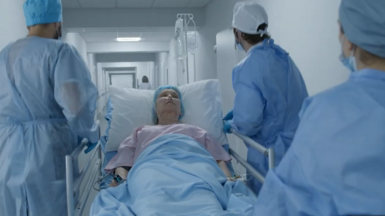Recommendation by the European Medicines Agency concerning Pandemrix vaccination and reports of narcolepsy in children and adolescentsArchived
EMA recommends restricting use in persons under 20 years of age Pandemrix to be used only in the absence of seasonal trivalent influenza vaccines, following link to very rare cases of narcolepsy in young people. Overall benefit-risk remains positive.
EMA/CHMP finalises a review of Pandemrix® under article 20 of the European (EC) Regulation 726/2004 recommending that the vaccine not be given to those under 20 years except in special circumstances
In April 2011 following findings of a possible association between use of the specific monovalent pandemic vaccine Pandemrix® and narcolepsy in children and adolescents in Finland and Sweden, the European Medicines Agency (EMA) Committee on Human Medicinal Products (CHMP) recommended that the product information for Pandemrix® should be amended.(1) This was done following a request from the European Commission under article 20 of the European (EC) Regulation 726/2004 on the regulation and supervision of medical products. The April amendment advised prescribers to take into account the results from the two countries where the association was observed and to perform an individual benefit-risk assessment when considering use of Pandemrix. This was an interim statement and EMA-CHMP promised to return to the topic in July 2011 to complete the Article 20 procedure by reviewing more analyses from the countries and emerging information from the Vaccine Adverse Events Surveillance and Communication (VAESCO) network’s study initiated by ECDC with the Brighton Collaboration.(1,2)
Since April 2011, further analyses in Sweden and Finland have strengthened the observed association. Indeed a second study of more severe narcolepsy with cataplexy from Sweden confirmed the earlier finding and the Finnish findings remained essentially unchanged.(3-5) None of these studies have found any risk of narcolepsy following Pandemrix® immunisation of adults (people 20 years and above).
The interim results from ECDC VAESCO multi-country case control study confirm the association in Finland amongst children and adolescents, while data analysis is underway for Sweden and for a number of other European Countries. VAESCO analyses demonstrated the presence of diagnostic bias (bias that vaccinated persons are diagnosed faster or more completely, possibly due to media attention surrounding the detection of the initial signal). However accounting for this as much as possible did not remove the significant association in Finland.(5) Also only looking at more severe cases of narcolepsy-cataplexy in Sweden (who are less likely to be affected by diagnostic bias) still found the same association as in the earlier study.(3,4) The VAESCO study will also take into account other possible risk factors, such as infections and other vaccinations.
This week the EMA-CHMP has recommended restricting use of Pandemrix® in people under age 20 years so that it would not be used in this age group, except in the unusual circumstance of trivalent seasonal influenza vaccines not being available. Further details are available as a statement on the EMA web-site with an accompanying set of questions and answers.[6] The recommendation was made in the light of the findings above and reported observed versus expected rates of narcolepsy from the spontaneous reporting of adverse events following immunization in other European countries including France and Norway and wider discussions at an expert meeting in the preceding week.(6)
ECDC comment (21 July 2011):
ECDC has been making information available from the studies in Sweden and Finland as they became available through a series of Public Health Development publications.(7) The statement by EMA-CHMP recognises that there is an association between vaccination with Pandemrix® and an increased risk of narcolepsy or narcolepsy with cataplexy amongst children and adolescents in Finland and Sweden.(6) This is probably in combination with some other co-factors and possible effect modifiers, that is factors which affect the risk of narcolepsy or alter the impact of other causes. Examples of the former could be an unobserved infection in the community and the latter host genetics. The published estimates are of high and statistically significant relative risks (2-5). The observed relative risk is 12 with the cohort approach in Finland and 6 in the VAESCO case control study, which used the same cases but adjusted for age, sex and calendar time. The estimates range between 4 and 6 in the Swedish cohort and case inventory studies depending on the type of analysis. Different sensitivity analyses varying the risk window for developing narcolepsy-cataplexy have changed those figures somewhat(3), but the relative risks were viewed by a number of European pharmacovigilance and pharmacoepidemiology experts to be too high to be an artefact and careful analyses have ruled out these being entirely due to diagnostic trends or the effect of media interest.(3-5) In Sweden the absolute risk was estimated at one new case of narcolepsy–cataplexy per 27,800 vaccinations for those aged 4 to 19 years (no absolute risk has been published for Finland).(3) WHO’s Global Committee on Vaccine Safety also made a statement in April.(8) Like EMA-CHMP it agreed that the findings were convincing and that further investigation was essential. However, the WHO Committee noted that an increased risk of narcolepsy was not observed outside these Nordic counties and that it had not previously been observed in association with any seasonal influenza vaccine, or vaccines against any other disease.
The ECDC VAESCO study has several strengths. This is a multi-country study where each site uses standardized methods and tools, reducing heterogeneity between countries; it is one of the first such studies in Europe. The scale of investigation has been unprecedented and will allow for a wider European picture. Flexibility in implementation of the study protocol has been provided, this allows for participation of countries with various healthcare systems and data availability, e.g. those which do not have large (national) linked databases to increase power. A-priori the design addressed many potential biases (e.g. diagnostic awareness, exposure, outcome misclassification). The case control design allows for the study of additional risk factors such as those mentioned above, which may later contribute to a better understanding of the disease.
It will be important to complete these studies and further work on the possible biological mechanisms involved. However it should be noted that these are difficult, complex and time consuming studies in vulnerable children and adolescents and their families, especially when they cover multiple countries, require examination of medical records and need independent case validation. Results of a study from Canada are also awaited. There another pandemic vaccine Arepanrix® very similar to Pandemrix® was used. It would also be helpful if more European countries come into the ECDC-VAESCO study, especially those where more children and adolescents were immunised not only with Pandemrix® but also other pandemic vaccines. The possible co-factors, environmental, genetic and other possible modifying factors that could have contributed to the observed increased risk all need to be further investigated. Also needing to be considered are the contributions of vaccine adjuvants as the vaccine in question contains an adjuvant while no effect has been reported to date with non-adjuvanted vaccines or vaccines with other adjuvants. Here it is important to recall that adjuvants have greatly benefited the efficiency and effectiveness of pandemic and other vaccines and therefore have an important future role in protecting against infectious diseases.(9) In addition, another pandemic vaccine, Focetria®, was used in southern Europe, contained one of the Pandemrix® adjuvant components squalene, and no reports of narcolepsy have been observed after vaccination with this vaccine.
There are other longer-term advantages of the ECDC-VAESCO collaboration. It is essentially building a European system of linked data-bases that can answer more than one question and derive and combine information from multiple countries. As such it has already proved its worth in demonstrating no association between pandemic vaccines and Guillain-Barré syndrome in Europe.(10) It is potentially able to take an observation and hypothesis from one country and test that in another setting where perhaps circumstances allow a wider comparison of exposure making the hypothesis more refutable. For example a difficulty of the studies in Finland and Sweden is that the only vaccine used was Pandemrix® so it is harder to isolate and test the specific vaccine hypothesis.(8) That is not to under-estimate the challenges facing VAESCO in combining data from multiple countries and systems and the need for enduring stable and independent funding.
Where does this leave advice on what vaccines to use in the coming in influenza season Again it should be noted that no such association has been reported with any seasonal influenza vaccines.(8) The ECDC advice is that the people in nationally determined seasonal influenza risk groups and other groups to whom vaccination is offered should accept vaccination with seasonal influenza vaccines - i.e. seasonal influenza vaccines should be used for preventing seasonal influenza.(11) It is important to protect against all the likely circulating influenza viruses for the coming 2011/12 season not just A(H1N1)2009 but also A(H3N2) and B viruses.(12)
Se all ECDC updates on influenza vaccination
Related diseases and public health areas
2009 influenza A (H1N1) pandemic
The 2009 influenza A(H1N1) pandemic was declared over in August 2010 by the World Health Organization. Europe has now entered a new inter-pandemic phase of seasonal influenza.
Influenza vaccine safety
Risks of an adverse event following influenza vaccination are far less common than complications related to influenza itself, and the adverse events are generally localised and mild.
Public health area
Immunisation and vaccines
Vaccines represent one of the most effective and cost-saving public health intervention.




